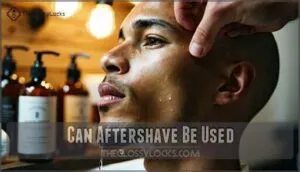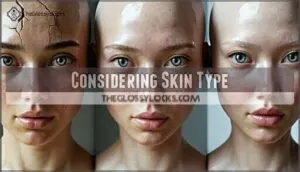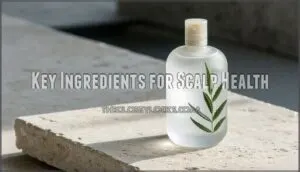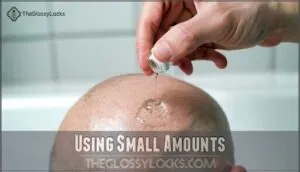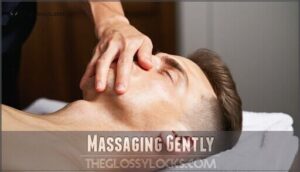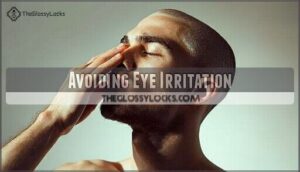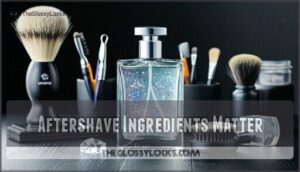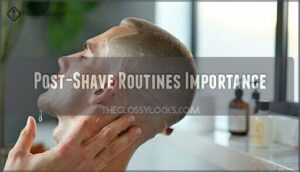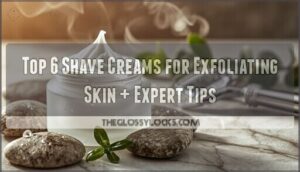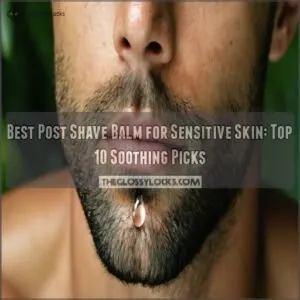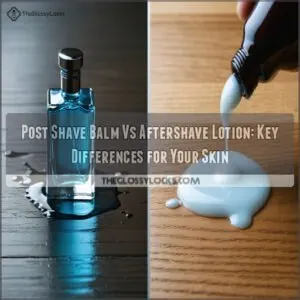This site is supported by our readers. We may earn a commission, at no cost to you, if you purchase through links.
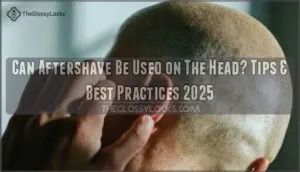
Your dome faces the same irritation risks as your face, so why treat it differently?
Aftershave helps reduce razor burn, prevents ingrown hairs, and fights off bacteria that love to party in tiny nicks and cuts.
Just remember, your scalp can be more sensitive than your cheeks, so start with alcohol-free formulas that won’t sting like a bee.
A small amount goes a long way – think dab, not splash, and with the right technique and ingredients, you can transform your head-shaving game completely.
Table Of Contents
- Key Takeaways
- Aftershave Use on Head
- Can Aftershave Be Used
- Choosing Right Aftershave
- Aftershave Application Tips
- Aftershave Ingredients Matter
- Post-Shave Routines Importance
- Maintaining Healthy Scalp
- Frequently Asked Questions (FAQs)
- What are aftershaves & how do they work?
- How do you apply a aftershave?
- What are the benefits of using aftershaves?
- What is the best aftershave?
- Does aftershave cause acne?
- What are the different types of aftershave products?
- Can you use aftershave on your head?
- What to put on my head after shaving it?
- What is the best thing to shave your head with?
- What else can aftershave be used for?
- Conclusion
Key Takeaways
- You can absolutely use aftershave on your head after shaving, and it’ll provide the same protective benefits as using it on your face – just choose alcohol-free formulas to avoid irritating your more sensitive scalp skin.
- You’ll want to apply only a dime-sized amount and massage it gently into your scalp using circular motions, being careful to keep the product away from your eyes since your head sits much closer to them than your face does.
- You should look for aftershaves containing moisturizing ingredients like aloe vera, glycerin, and tea tree oil while avoiding high-alcohol formulas that can dry out and irritate your freshly shaved scalp.
- You’ll get the best results by following a complete post-shave routine that includes gentle cleansing, applying moisturizing balm, patting dry with a soft towel, and protecting your scalp from sun exposure since you’ve lost your hair’s natural UV protection.
Aftershave Use on Head
You can definitely use aftershave on your head after shaving, and it’ll help keep your scalp healthy and comfortable.
Just like your face needs care after a shave, your freshly shaved head benefits from the moisturizing and soothing properties that good aftershave products provide.
Benefits for Scalp Health
Using aftershave on your bald head delivers powerful scalp health benefits that’ll transform your shaving routine.
Your scalp gets antiseptic properties that protect against infection while enjoying moisture replenishment after each shave.
Your scalp deserves the same post-shave care as your face – antiseptic protection plus moisture equals healthy, comfortable skin.
Here’s what aftershave benefits head care provides:
- Scalp soothing – Calms irritation and reduces redness instantly
- Bacteria protection – Prevents infections in tiny nicks and cuts
- Scent enhancement – Leaves your scalp smelling fresh all day
This creates a healthier scalp overall.
Many users find it helps in reducing razor burn.
Importance of Moisturizing
Moisturizing your bald head after shaving keeps your scalp healthy and comfortable.
Hydration benefits include dandruff prevention and improved scalp health through better moisture retention.
When you moisturize regularly, your skin stays soft and protected.
Choose the right aftershave for bald head care – look for a quality scalp moisturizer that provides lasting hydration without leaving residue, ensuring better moisture retention and overall scalp health.
Reducing Irritation and Razor Burn
Beyond keeping your scalp hydrated, aftershave’s antiseptic properties tackle razor burn head-on.
You’ll notice less redness and postshave irritation when you choose products with witch hazel or tea tree oil.
Cold compress application right after shaving helps too.
Proper technique paired with gentle lotion reduces scalp irritation substantially, and your skin adapts over time, making each shave smoother than the last with less redness.
Can Aftershave Be Used
Yes, aftershave can absolutely be used on your head, and it’s actually a smart move for anyone who shaves their scalp. Regular aftershave works perfectly fine on your dome, provided it doesn’t cause irritation. The key is choosing the right formula for your skin type.
Scalp aftershave benefits include disinfecting minor nicks, reducing redness, and replenishing moisture lost during shaving. Aftershave for bald head use differs slightly from facial application – your scalp needs extra hydration since it’s newly exposed to the elements.
Watch out for alcohol content in your chosen product. High-alcohol formulas can dry out your scalp, leading to flakiness and discomfort. Aftershave alternatives like balms or lotions work better than traditional splashes for head aftershave use.
Some products contain growth inhibitors that may weaken hair follicles, giving you an extra day between shaves. Remember to check product expiration dates, as scalp aftershave effectiveness diminishes over time.
Choosing Right Aftershave
You’ll want to pick an aftershave that matches your scalp’s specific needs, just like you wouldn’t wear winter boots to the beach.
Your skin type, whether it’s dry, oily, or sensitive, determines which ingredients will soothe your freshly shaved head without causing irritation or breakouts.
Considering Skin Type
Your skin type determines which aftershave for bald head works best. If you’ve got dry skin or dry scalp, choose moisturizing formulas with natural oils.
Oily skin benefits from water-based products that won’t clog pores. Sensitive skin needs gentle, alcohol-free options with soothing ingredients.
Normal skin and combination skin can handle most aftershaves comfortably. For sensitive skin, consider using fragrance-free shaving cream to minimize reactions, and opt for products suitable for your specific skin type to ensure the best results.
Selecting Fragrance-Free Options
Fragrance-free aftershave for bald head works best for sensitive scalps and those with allergy concerns.
Added scents can trigger ingredient sensitivities, causing redness or burning.
Natural alternatives without artificial fragrances offer reduced irritation while still providing scalp care for sensitive skin.
Consider browsing options for fragrance-free shaving products for sensitive skin.
Your nose might miss the cologne smell, but your scalp will thank you later for using fragrance-free aftershave and opting for natural alternatives.
Key Ingredients for Scalp Health
When choosing aftershave ingredients for scalp health, you’ll want powerhouse components that work double duty.
Aloe benefits include soothing irritation while glycerin hydration locks in moisture. Tea tree oil fights bacteria, and shea butter nourishes deeply.
Antioxidants from natural ingredients protect your scalp from environmental damage.
As the scalp ages rapidly, targeted care is essential.
These aftershave ingredients head straight to work, making skin care and scalp care effortless.
Aftershave Application Tips
Applying aftershave to your freshly shaved head requires a gentle touch and the right technique to avoid irritation.
You’ll want to use just a dime-sized amount and massage it in slowly, being careful to keep the product away from your eyes since your scalp sits much closer to them than your face does, which demands a careful and slow approach.
Using Small Amounts
Once you’ve picked your aftershave for bald head care, proper aftershave application head technique starts with the right amount.
A dime-sized portion prevents aftershave irritation head while ensuring product absorption. Too much creates buildup that clogs pores and wastes money.
Here’s your Amount Frequency guide for aftershave head safety:
- Start with a dime-sized amount – This covers your entire scalp without overwhelming sensitive skin
- Add more only if needed – Scalp Sensitivity varies, so listen to your skin’s response
- Less is more for oily scalps – Excess product sits on surface instead of absorbing properly
- Reapply sparingly throughout day – Even Distribution matters more than quantity for lasting comfort
Massaging Gently
After applying your aftershave on head, gentle pressure works wonders.
Use circular motions across your scalp to boost circulation benefits and enhance absorption. Your fingertips should glide smoothly, avoiding irritation through proper relaxation techniques.
This scalp care aftershave routine helps the product penetrate deeper while soothing your skin naturally.
| Massage Technique | Benefits |
|---|---|
| Circular Motions | Improves blood flow and product absorption |
| Light Fingertip Pressure | Prevents irritation while distributing aftershave evenly |
| 30-Second Duration | Allows complete penetration without over-stimulation |
Avoiding Eye Irritation
While massaging aftershave into your scalp, keep your eyes protected from accidental contact. Product runoff can cause serious irritation, especially with sensitive skin.
Maintain proper application distance from your face, and if aftershave touches your eyes, immediate rinsing prevents burning. Ingredient sensitivity varies, so choose scalp soothing formulas carefully.
- Tilt your head backward when applying aftershave to prevent dripping toward your eyes
- Keep a damp washcloth nearby for quick cleanup if product runs down your forehead
- Close your eyes tightly during application, like you’re making a wish on birthday candles
- Use your free hand as a shield, creating a barrier between the aftershave and your face
Aftershave Ingredients Matter
You’ll find that the specific ingredients in your aftershave can make or break your scalp care routine.
The right combination of moisturizers, antiseptics, and soothing agents determines whether you’ll experience comfort or irritation after shaving your head.
Aloe Vera for Nourishment
Aloe Vera stands as nature’s own healing powerhouse for your freshly shaved scalp.
This green wonder delivers instant scalp soothing and natural relief from razor burn. Aloe benefits include deep skin healing properties that reduce inflammation while providing essential aloe hydration.
When you’re choosing aftershave for your bald head, look for products containing this gentle moisturizer ingredient. You can find a variety of aloe vera aftershaves online, which can be a great way to utilize the natural relief and aloe hydration properties of Aloe Vera.
Glycerin for Hydration
Glycerin acts like a moisture magnet for your scalp, drawing water from the air and sealing it into your skin.
Your scalp craves moisture like a desert craves rain – aftershave delivers exactly what it needs.
This powerhouse ingredient strengthens your skin barrier while maintaining ideal hydration levels after shaving. It also helps guarantee a smoother, irritation-free shave.
- Humectant Properties: Glycerin pulls moisture from the environment into your scalp
- Skin Barrier: Reinforces your scalp’s natural protective layer against dryness
- Product Formulations: Look for aftershave containing glycerine for lasting moisturization
Tea Tree Oil for Antibacterial Properties
Tea tree oil’s antibacterial properties make it a powerhouse ingredient for aftershave formulations.
You’ll find this natural antiseptic helps prevent infections in minor nicks while soothing your scalp.
Look for products with 0.5-2% oil concentration to avoid skin reactions. Higher dilution ratios work better for sensitive scalps.
Tea tree benefits include reducing inflammation and keeping your freshly shaved head clean and healthy. Consider exploring options for tea tree aftershaves.
Post-Shave Routines Importance
Your post-shave routine matters just as much as the actual shave, especially when you’re working with sensitive scalp skin.
Following the right steps after you finish shaving helps prevent irritation, keeps your head moisturized, and guarantees you won’t deal with razor burn or uncomfortable dryness later.
Washing With Gentle Cleanser
After applying the right ingredients to your scalp, proper cleansing sets the foundation for healthy scalp care.
Choose a gentle cleanser that won’t strip your skin’s natural oils after shaving. Your scalp needs tender care, not harsh scrubbing.
Here’s your post-shave cleansing roadmap:
- Cleanser Ingredients – Look for sulfate-free formulas with natural moisturizers
- Washing Frequency – Cleanse once daily, twice maximum to avoid over-drying
- Water Temperature – Use lukewarm water; hot water irritates freshly shaved skin
- Cleanser Application – Massage gently with fingertips, never scrub vigorously
- Drying Methods – Pat with soft towel; rubbing causes irritation and redness
Applying Moisturizing Balm
After cleansing, you’ll want to lock in moisture with a quality aftershave balm. Think of it as your scalp’s drink of water after the shaving marathon.
A quality balm can also offer antiseptic properties to protect against infection.
Apply a dime-sized amount and massage gently until absorbed—usually within two minutes.
| Balm Factor | Recommendation | Why It Matters |
|---|---|---|
| Application Frequency | After each shave | Maintains consistent hydration |
| Proper Amount | Dime-sized portion | Prevents greasiness, guarantees coverage |
| Absorption Time | 2-3 minutes | Complete scalp penetration |
Patting Dry With Soft Towel
Proper drying technique matters just as much as your aftershave choice.
After applying moisturizing balm to your bald head, gently pat the scalp with a soft towel to remove excess moisture without causing irritation.
- Towel Material: Choose cotton or microfiber for maximum softness importance
- Drying Technique: Pat, don’t rub, to avoid damage
- Preventing Irritation: Let skin breathe before additional hydration
The instructions provided emphasize the importance of proper drying and care for a bald head, highlighting key considerations for towel material, drying technique, and preventing irritation.
Maintaining Healthy Scalp
You’ll want to treat your scalp like any other part of your skin that needs regular care and attention.
Keeping your head healthy means avoiding too much shaving, protecting it from the sun’s harsh rays, and drinking enough water to keep your skin properly hydrated from the inside out, which involves regular care.
Avoiding Over-Shaving
Your scalp needs recovery time between shaves. Shaving frequency matters more than you think – daily head shaving can irritate sensitive skin and cause razor burn.
Sharp blades reduce friction, while proper shaving technique prevents nicks. Allow 24-48 hours between sessions for healing.
Gentle exfoliation timing helps, but overdoing it damages your scalp. Quality aftershave soothes irritation effectively, and sharp blades along with proper shaving technique are crucial.
Protecting From Sun Exposure
Your freshly shaved scalp becomes vulnerable to harmful UV damage without hair’s natural protection.
Apply broad-spectrum sunscreen with SPF 30 or higher before heading outdoors. Don’t forget regular reapplication every two hours for effective scalp protection.
Many aftershave products now include built-in UV protection, creating convenient product combinations that shield your skin while maintaining proper scalp care throughout sunny days.
Staying Hydrated for Scalp Health
Most people don’t realize that proper hydration starts from within, making water intake essential for scalp moisturizing after shaving your bald head.
Dehydration directly impacts your scalp’s ability to heal and stay healthy.
Essential hydration practices include:
- Drink at least 2 liters daily to prevent scalp dehydration
- Choose hydrating foods like fatty fish and spinach
- Time your hydration around physical activity
- Consider humectants benefits in topical products
Frequently Asked Questions (FAQs)
What are aftershaves & how do they work?
Studies show 70% of men skip aftershave, missing essential skin protection.
Aftershaves are antiseptic solutions that disinfect razor cuts, reduce irritation, and replenish moisture lost during shaving.
They work by calming your skin and preventing bacterial infections.
How do you apply a aftershave?
After shaving, rinse your head with cold water and pat dry.
Apply a dime-sized amount of aftershave while skin’s still damp. Gently rub it in until fully absorbed, covering your entire scalp and neck area.
What are the benefits of using aftershaves?
Like a healing balm for battle-worn skin, aftershave works as your scalp’s best friend.
You’ll get antiseptic protection for cuts, reduced irritation and redness, plus essential moisture that prevents dryness and keeps your head feeling smooth.
What is the best aftershave?
You’ll want an aftershave designed for sensitive scalps with moisturizing ingredients like aloe vera, shea butter, and minimal alcohol.
Bee Bald Healing Balm and Jack Black Post Shave Cooling Gel top the list.
Does aftershave cause acne?
Aftershave won’t directly cause acne, but certain ingredients can clog pores if you’re prone to breakouts.
Choose alcohol-free, non-comedogenic formulas with gentle ingredients like aloe vera to keep your scalp clear and comfortable.
What are the different types of aftershave products?
Most men use only one type of aftershave, but you’ll find three main varieties: alcohol-based splashes that disinfect, moisturizing balms for dry skin, and cooling gels that soothe irritation without over-drying.
Can you use aftershave on your head?
Yes, you can use regular aftershave on your head if it doesn’t cause irritation.
Choose lotions, balms, or tonics over drying splashes.
Test on a small scalp area first for safety.
What to put on my head after shaving it?
Funny how your scalp craves the same care as your face after shaving.
Apply aftershave balm, aloe vera gel, or moisturizing lotion to soothe irritation and prevent dryness.
Don’t forget sunscreen for protection.
What is the best thing to shave your head with?
You’ll want a quality multi-blade razor or electric shaver designed for head shaving.
Cartridge razors with three to five blades work great, while rotary electric shavers offer convenience and reduce nicks.
What else can aftershave be used for?
Like a Swiss Army knife for your skin, aftershave’s versatility extends beyond shaving.
You can use it as a deodorant, facial toner, or antiseptic for minor cuts.
It’ll also refresh your neck and chest areas after workouts.
Conclusion
Mastering head aftershave is like learning to drive – once you’ve got the basics down, it becomes second nature.
Yes, aftershave can absolutely be used on your head when you choose alcohol-free formulas and apply them gently.
Your scalp deserves the same care as your face, so don’t skip this essential step.
With proper technique, quality ingredients, and consistent post-shave routines, you’ll keep your dome smooth, healthy, and irritation-free for years to come.
- https://www.medicalnewstoday.com/articles/325886
- https://skullshaver.eu/blogs/news/how-to-care-for-a-shaved-head-ultimate-guide-2019
- https://www.lelabofragrances.ca/after-shave-balm-700.html
- https://www.shiseido.co.nz/shiseido-men-moisturizing-recovery-cream-1011438110.html
- https://www.getjackblack.com/post-shave-cooling-gel.aspx

